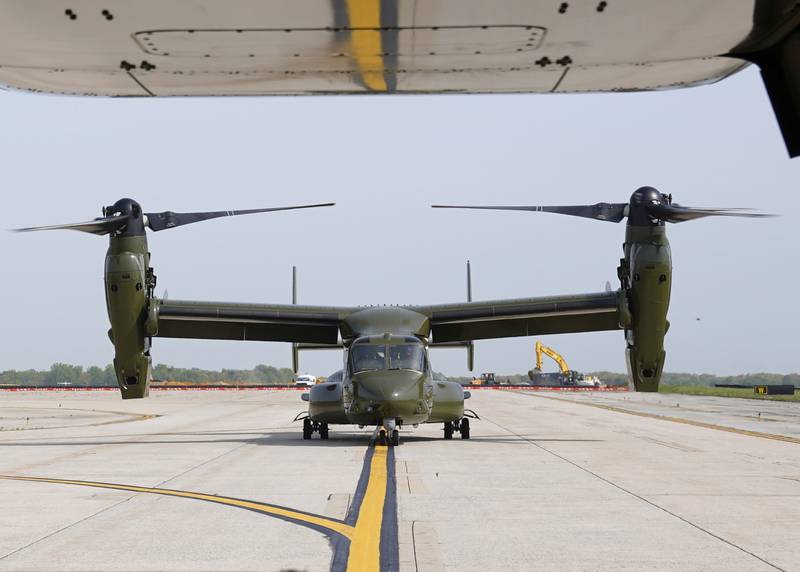The U.S. military doesn’t expect its fleet of more than 400 V-22 Osprey tiltrotor aircraft to fully resume normal flight operations until at least the middle of 2025, a Navy admiral in charge of the joint program told a House Oversight subcommittee Wednesday.
Naval Air Systems Command boss Vice Adm. Carl Chebi, whose office oversees Ospreys in use across the Air Force, Navy and Marine Corps, said a review that is probing whether the enterprise has adequate manning, training and equipment, will last another six to nine months.
RELATED

“As we have findings from the comprehensive review, I will take the necessary actions to ensure continued safe flight operations,” Chebi told the panel of lawmakers.
The command allowed the Osprey to begin returning to the air — with flight restrictions in place — in early March, three months after the fleet was grounded in early December following an Air Force CV-22 crash off the coast of Japan that killed all eight airmen on board.
Ospreys can be flown like an airplane and take off and land like a helicopter, making them useful for aircraft carrier landings as well as for special operators entering austere environments.
The Marine Corps operates hundreds of the aircraft, while the Air Force and Navy own around 50 and 30, respectively. Marine Ospreys are starting to reenter the fray; 10 aircraft from Marine Medium Tiltrotor Squadron 268 headed to Hawaii in May in preparation for a training exercise in Australia, while the 24th Marine Expeditionary Unit is using them in Sweden as part of Exercise Baltic Operations.
The Navy’s CMV-22 fleet remains sidelined from performing its carrier support mission at sea, service officials said Wednesday. Despite getting the green light to resume regular missions, the services are barred from flying more than 30 minutes from an airfield where they could land in case of an emergency, according to Military.com.
Osprey crews at Cannon Air Force Base, New Mexico, have begun rebuilding their skills in anticipation of returning to normal ops, and other squadrons are getting close to flying again, Air Force Special Operations Command spokesperson Lt. Col. Rebecca Heyse told Air Force Times.
An investigation into the Air Force’s Nov. 29 CV-22 crash is nearing completion, with briefings for families expected in the coming weeks. The military has said that accident was the result of a material failure that hadn’t been seen before on the Osprey.
Ospreys have suffered a string of fatal crashes since the U.S. military introduced them into special operations more than two decades ago, including four mishaps that have killed 20 service members since March 2022. The military grounded the Ospreys in 2022 and again in 2023, after a series of “hard clutch engagements” that occurred when the input quill assembly, which attaches the Osprey’s engine to its proprotor gear box, wore out earlier than expected.
On Wednesday, Chebi and Gary Kurtz, program executive officer for anti-submarine, assault and special mission programs including the Osprey, told lawmakers that a redesigned clutch is expected to begin testing soon.
“We anticipate that we will have a new clutch fielding in the mid-2025 timeframe,” Kurtz said.
Faced by Gold Star families who held photos of loved ones during Wednesday’s hearing, lawmakers questioned the aircraft’s mishap and readiness rates, the latter of which have struggled in recent years due to woes like corrosion issues and a lack of available parts.
For example, the Air Force CV-22 fleet’s mission-capable rate, or the percentage of time that the aircraft can perform at least one of its core missions, hovered around 50% between fiscal years 2020 and 2022, according to data provided to Air Force Times.
Members of the House Oversight Committee also pushed for more transparency, saying the military wasn’t sharing enough about the findings on its recent crashes.
Some on Capitol Hill are running out of patience.
Rep. Stephen Lynch, a Democrat from Massachusetts, called for the entire fleet to be grounded while the military works works out a fix for the clutch.
“If another Osprey goes down, we’re done,” Lynch said. “This program’s done.”
Courtney Mabeus-Brown is the senior reporter at Air Force Times. She is an award-winning journalist who previously covered the military for Navy Times and The Virginian-Pilot in Norfolk, Va., where she first set foot on an aircraft carrier. Her work has also appeared in The New York Times, The Washington Post, Foreign Policy and more.
- SEO Powered Content & PR Distribution. Get Amplified Today.
- PlatoData.Network Vertical Generative Ai. Empower Yourself. Access Here.
- PlatoAiStream. Web3 Intelligence. Knowledge Amplified. Access Here.
- PlatoESG. Carbon, CleanTech, Energy, Environment, Solar, Waste Management. Access Here.
- PlatoHealth. Biotech and Clinical Trials Intelligence. Access Here.
- Source: https://www.defensenews.com/news/your-air-force/2024/06/12/osprey-fleet-wont-return-to-full-flight-operations-until-2025/



